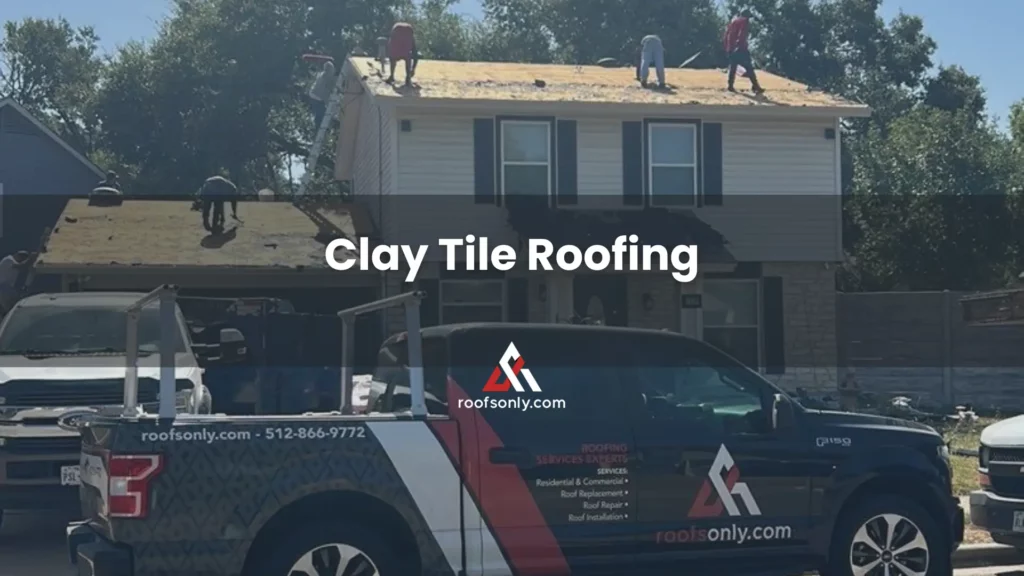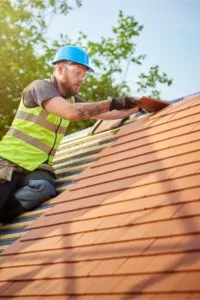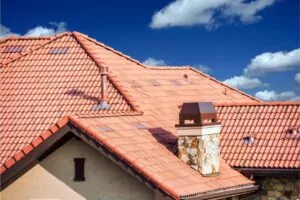
Clay tile roofing embodies a blend of elegance and longevity, offering lifespans of up to 70 years, significantly surpassing traditional shingles. At RoofsOnly.com, we specialize in a comprehensive range of clay tile roofing services, including repair, installation, and replacement.
Catering to the unique needs of each home, our team ensures that whether it’s a meticulous restoration, a new installation, or a complete roof replacement, the result is a perfect fusion of style and durability. For expert clay tile roofing services in Texas, trust our skilled contractors to maintain the beauty and resilience of your home’s roof.
Benefits of Clay Tile Roofing
In Texas, known for its long, hot summers and storms, clay tile roofing stands as a resilient choice for homes. With 230 days of bright sun annually and 35 inches of rain, these conditions can be harsh on materials like asphalt tiles. However, clay tiles excel in this environment, offering up to 100 years of protection when properly installed, far surpassing the lifespan of other roofing materials.
Key Advantages of Clay Tile Roofing:
- Exceptional Durability: Clay tiles can last up to three times longer than asphalt shingles, often enduring for several generations. They are capable of withstanding severe weather, including winds up to 150 miles per hour and large hail.
- Energy Efficiency: Their unique curved shape allows hot air to escape, reducing roof temperatures and lessening the burden on air conditioning systems.
- Low Maintenance and Repair Costs: While clay tiles are heavy, brittle, and can be expensive, they require minimal maintenance. Repairs typically involve matching the style and color of the original tiles, effectively restoring the roof’s integrity.
- Aesthetic Appeal: Clay tiles enhance the beauty of a home, making them a desirable feature for resale. They are available in various styles and colors, adding to the home’s visual appeal.
Thermal Protection: Unlike other materials, clay tiles offer superior thermal protection, shielding the roof from the sun’s rays.
Despite some challenges in installation and their weight, the benefits of clay tile roofing in Texas’ demanding climate are significant. They provide a robust, energy-efficient, and visually appealing roofing solution.
For expert clay or concrete roof repair or replacement in Texas, RoofsOnly.com ensures seamless integration of new or repaired tiles with the original roof. Clay tile roofing not only offers lasting protection but also contributes to the overall aesthetic and value of Texas homes.
Clay Tile Roofing Services in Texas

Our Texas-based team specializes in clay tile roofing, providing a range of services to ensure your home’s protection and aesthetic appeal:
Clay Tile Roof Installation
We offer expert installation for new builds or additions, using high-quality clay tiles. Our focus is on matching your home’s style while ensuring durability and longevity.
Clay Tile Roof Repair
Skilled in addressing issues like leaks, cracks, and weather damage, we provide timely and cost-effective repair solutions. Our process includes a thorough assessment and precise repair plan to maintain your roof’s integrity.
Clay Tile Roof Replacement
For older or significantly damaged roofs, we offer complete replacement services. A new roof not only fixes current problems but also prevents future issues, adding value to your home.
Clay Tile Roof Maintenance
Clay tile roof maintenance is vital for their longevity, particularly in Texas’ harsh climate. Regular inspections are essential to identify and repair any damage, such as cracks or missing tiles. Periodic cleaning is also crucial to prevent build-up of mildew, dirt, or algae, ensuring the roof’s durability and aesthetic appeal.
At RoofsOnly.com, we cover all aspects of clay tile roofing, from installation and repair to maintenance and replacement, ensuring your roof remains in top condition. Trust our expertise for a safe, beautiful, and long-lasting clay tile roof in Texas.
Signs Your Clay Roof Needs to Be Replaced or Replaced
If your clay roof is showing signs of age and damage, it’s important to assess whether it needs repair or replacement. Here are some key indicators to look out for:
- Cracked Tiles: While clay tiles are known for their strength and durability, they can become susceptible to cracking, chipping, or buckling as they age, especially under weight. If you notice minor cracking or chipping, a repair might be sufficient. However, extensive damage often calls for replacement.
- Eave Stains: Stains underneath the eaves of your roof can indicate ineffective water diversion. This could be a sign that your roof needs professional attention. Minor staining might require simple repairs, but persistent or widespread staining could suggest the need for a more comprehensive solution, like replacement.
- Moisture on the Underlayment: The underlayment, which lies between the clay tiles and the roof deck, provides a secondary layer of protection against leaks. If you find moisture pooling on the underlayment, or if it shows significant wear and tear, this could indicate that your clay tiles are no longer effectively repelling water. In cases of minor moisture issues, repairs may resolve the problem, but continuous or severe water accumulation might necessitate roof replacement.
If your roof is old and exhibits these signs of damage, contact RoofsOnly.com to schedule a consultation. We can help you determine whether roof repair or replacement is the best course of action for your roof and provide you with an estimate.
Clay Tile Materials and Aesthetics
Clay tile roofing, celebrated for centuries for its versatility and aesthetic appeal, comes in various styles:
- Mission Tiles: Common in the Southwestern U.S., these barrel-designed tiles alternate between convex and concave shapes, offering a textured look.
- French Tiles: Known for their two concave grooves, they interlock easily and efficiently redirect roof runoff.
- Spanish Tiles: Barrel-shaped like Mission tiles but in an S-shape, these tiles streamline installation and provide a classic appearance.
- Flat Tiles: Available with or without interlocking lips and grooves, they offer diverse installation options for different aesthetics.
At RoofsOnly.com of Texas, we focus on high-quality clay materials that match your style and budget, ensuring durability and beauty.
Concrete roofing tiles, another popular choice, are made from sand, water, and iron oxide. Heavier than asphalt shingles, they require experienced installers, especially for complex roof shapes. Aesthetically, concrete tiles offer a wide range, from low-depth for a flat look to high-profile for a Spanish terracotta style, available in various colors including earth tones and subtle hues.
Both clay and concrete tiles provide homeowners with a durable, visually appealing roofing solution, enhancing the elegance and character of their homes.
Contact Us About Your Clay Roofing Project Today

Clay tile roofing is more than just a protective layer; it’s a blend of tradition, style, and unmatched durability. If you’re considering clay tile roofing for your Texas home, there’s no better partner than RoofsOnly.com.
Ready to transform your home with clay tile roofing? Contact us online today or call us at (512) 746-7090 to schedule an appointment with one of our roofing experts.
Frequently Asked Questions
How much does a clay/tile roof cost?
While clay/tile roofs are an investment, their longevity and aesthetic appeal make them worth every penny. For a detailed estimate tailored to your needs, reach out to our RoofsOnly.com experts. Or, use our roofing project calculator for a rough estimate.
When does a clay tile roof need to be replaced?
A well-maintained clay/tile roof can last up to 50 years or more. Regular inspections and timely repairs can extend its lifespan. If you notice any signs of damage or wear, it’s best to consult with a roofing specialist.
Does a clay tile roof increase home value?
Absolutely! A clay/tile roof not only enhances the aesthetic appeal of your home but also adds to its market value, thanks to its durability and timeless charm.

